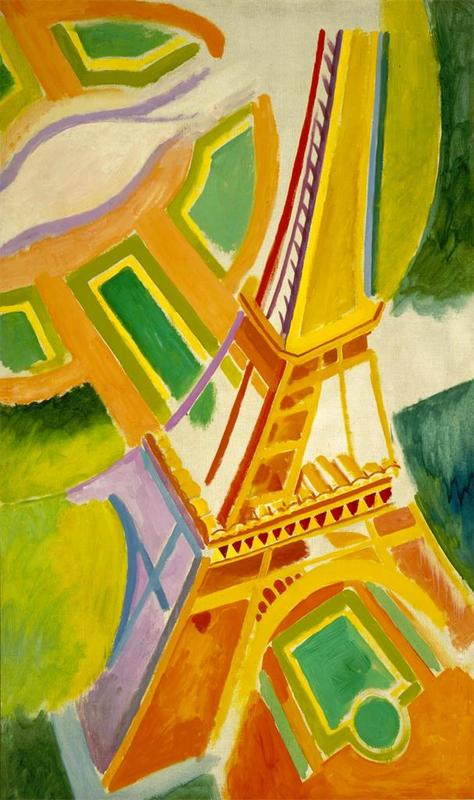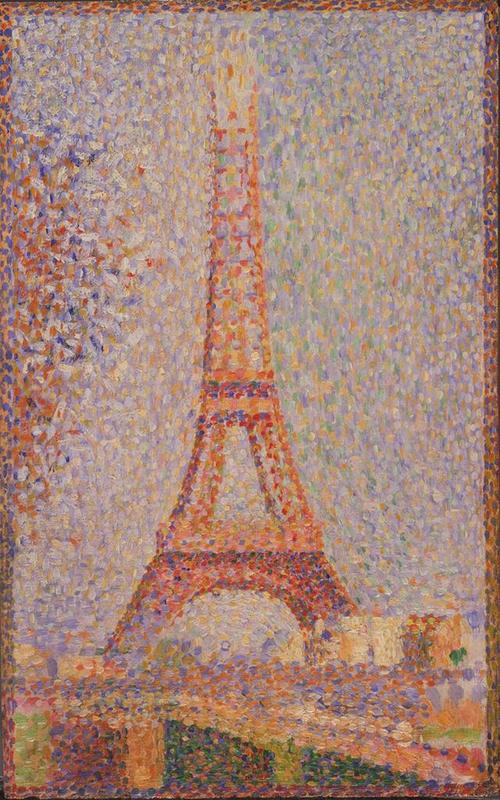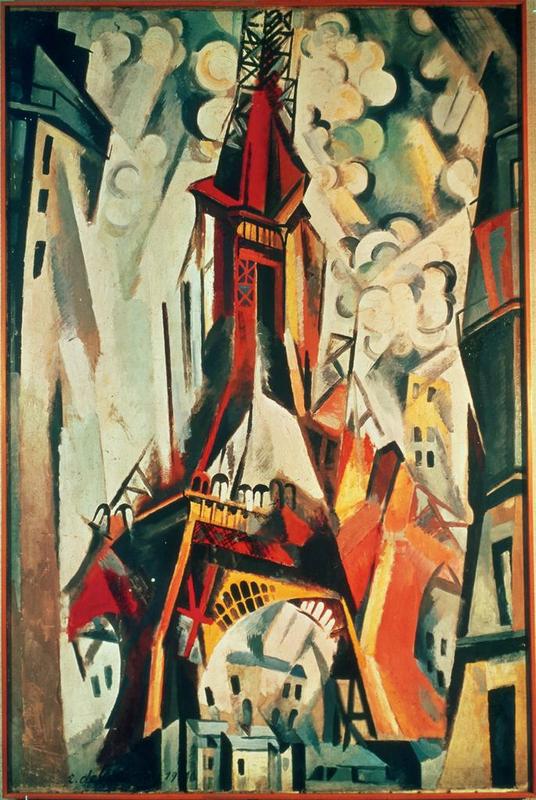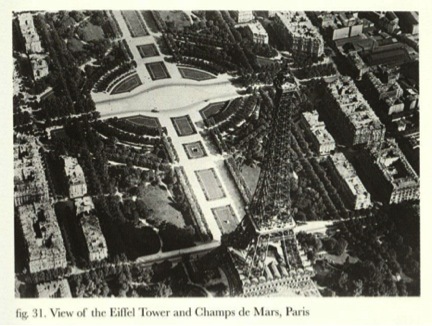Robert Delaunay's Eiffel Tower

Robert Delaunay, "Eiffel Tower," 1924. Oil on Canvas, 161.6 cm x 96.8 cm. Saint Louis Art Museum, Saint Louis.
Robert Delaunay, an artist who lived in Paris between 1900 and 1940, is best known for his paintings the Eiffel Tower Series. He painted the first series between 1909 and 1912 and a second series between 1920 and 1930.[i] This painting from 1924 is from the second series where Delaunay paints in a style known as Orphic Cubism, where color is used to envision form through planes and lines of contrasting colors. As Delaunay wrote in his journal, the Eiffel Tower was the “barometer of [his] art,” a symbol of Paris and its success as a modern haven.[ii] Delaunay saw the Eiffel Tower as the pride of France as the country stepped boldly into the modern age.[iii] Like other artists that relayed their urban experiences by painting cityscapes, Delaunay used the structure as a template upon which he conveyed his imagined visions and perceptions of Paris. Unlike the German Expressionists’ typically chaotic and dark paintings of urban scenes, Delaunay’s post-war Eiffel Tower series celebrates the enthusiastic feeling for progress that the modern metropolis would allow. By 1924 Paris was a center of innovation and recreating the Eiffel Tower as he imagined it allowed Delaunay to communicate his own optimism for modern life.

Figure 1
Georges Seurat, "Tour Eiffel,"Oil on Canvas. 24 x 15 cm. The Fine Arts Museum of San Francisco, San Francisco.
Robert Delaunay, influenced by the Post-Impressionists and the Fauvists, transformed the expression of color on canvas by painting the effect of “simultaneous contrasting colors.”[iv] Color, more than any visual element of a painting, can engage the sensation of sight and activate the eye of the viewer. Beginning in the 1880s in Germany and France, artists began manipulating color outside of its accepted purpose as a pictorial element that mirrored pigment, light, and color as it was in reality. Georges Seurat took a scientific approach in applying color theory with his pointillist paintings, while later on the Fauvists began creating imagined forms with flat planes of bright colors. Comparing Eiffel Tower to Seurat’s painting of the monument from 1889, it is apparent that Delaunay’s particular use of certain colors and careful placement thereof to mimic the effects of light on the monument is similar to Seurat’s scientific use of color theory (Figure 1). However, Delaunay has flipped Seurat’s notion of capturing light by varying only application and intensity of a realistic color. Instead, he sought to capture light only through bold and imaginitive Fauvist-inspired pigment.

Figure 2
Robert Delaunay, "Eiffel Tower," 1910. Oil on Canvas, 20 cm x 16 cm. Solomon Guggenheim Museum, New York City.
The more Delaunay painted the Eiffel tower, the more abstracted it became. According to Mark Roesenthal, author of Visions of Paris: Robert Delaunay's Series, by the time Delaunay painted the monument in 1924, the artist had “…studied it from above, and below, inside and out, from near and far, by day and by night. He absorbed its every mood, perspective, and light effect.”[v] Over years of study, he was able to conquer the structure by mastering perspective of the tower from all possible dimensions and aspects. Initially, as in Eiffel Tower 1910, (Figure 2), Delaunay focused on deconstructing the tower in its space so that it emerges from a variety of elements, standing tall in a swirling environment. He paints in Cubist style, choosing to deconstruct via lines and shapes rather than by color. Only once he was able to branch away from Cubism around 1913 and focus on color as the pictorial device to fragment did Delaunay pioneer Orphic Cubism. By his painting in 1924, his shift in style is evidenced by the Eiffel Tower no longer being a singular form emerging from fragmented space but rather as the object of fragmentation itself. As the viewer comes closer to the painting, the Eiffel Tower loses its sense of solidness as a whole form and instead becomes a grid work of shapes and lines. Thus, Delaunay’s fixated study of the Eiffel Tower during his life was due to both an artistic fascination with its form as well as to his perception of the tower as a shining beacon of France’s strength in progress.

Figure 3
View of the Eiffel Tower and Champs de Mars, Paris. Photograph reproduced in Mark Rosenthanl, Visions of Paris: Robert Delaunay’s Series (New York, NY: Guggenheim Museum, 1997), 61.
In Eiffel Tower, painted in 1924, an aerial perspective of the tower and the range of colors used make it seem near at hand, while simultaneously magnificent in its awesome size and vertically stretching orientation. The aerial perspective on the Eiffel Tower creates an aura of grandiosity and heavenward verticality. The top of the tower is cut off and the entire piece framed as if viewed from a higher window. Delaunay paints as if the observer was looking down on the entirety of Paris through a window but could only see the Eiffel Tower, communicating the dominance of the Eiffel Tower over the entirety of Paris as one observes it from above. A contemporary photograph of the monument at the time period from the same perspective illustrates how vertical and domineering the tower truly looked from above (Figure 3). This mobile perspective in Eiffel Tower also implicates the viewer as an observer and the artist as the imaginer, emphasizing that Delaunay’s imagination has ordered the visual elements at his disposal to paint Eiffel Tower.
The range of contrasting colors, Delaunay’s main focus, creates an optical effect where every color zone is pushed forward or backward in space by its neighbor. Delaunay wrote about this idea of simultaneous colors (or simultaneity) as “…a certain combination of colors, in harmonic contrast with each other, can reproduce the movement of light.”[vi] Delaunay realized that light was “actualized through color” and thus when contrasting colors to intensify them one could capture the movement of light that occurred within each hue.[vii] Eiffel Tower combines many complementary and dissonant colors, ultimately each working together so that color has taken over the function of solid form. Additionally, light seems to be reverberating throughout the entire canvas because of the ordered layering of colors. The flatness of the painting only becomes apparent upon close viewing, because the juxtaposition of darker colors with passages of white creates a sculptural sense of recession into space. The colors in Eiffel Tower communicate the vibrancy and dynamism of the urban environment in Paris.
By being “imaginative, not imitative” Delaunay transforms the image of a recognizable monument to a personally relevant image conveying the energy of urbanism and modernity.[viii] The Eiffel Tower was a universal symbol for human growth in the metropolis and a personal connection to innovation Delaunay sought over the course of his career. His pioneering of Orphism culminates the century-long exploration by artists to extract the properties of color and manipulate them to give new meaning to it as a communicator of sensation and thought. In contrast to German Expressionists, Delaunay forgoes personal relevancy to his subject matter in favor of more aesthetic exploration. Meidner and Kirchner could not truthfully embrace a nationalistic identity at a time when Berlin seemed to be collapsing. Instead, they sought to transform thoughts of pessimism on modernity and personal visions of ruin into expressive images of city life and the cityscape of Berlin. Delaunay’s work reflects French optimism in the immediate years after its victory over Germany in World War I; hence he creates a nationalistic piece with a monument to urbanism in Eiffel Tower.
[i] Gustav Vriesen and Max Imadahl, Robert Delaunay: Light and Color (New York, H. N. Abrams, 1969), 66.
[ii] Vriesen and Imadahl, Robert Delaunay: Light and Color. 71.
[iii] William Thompson, “The Symbol of Paris: Writing the Eiffel Tower,” The French Review: 1130-40, accessed February 1, 2015.
[iv] Mark Roesenthal, “Visions of Paris: Robert Delaunay’s Series,” 77.
[v] Roesenthal, “Visions of Paris: Robert Delaunay’s Series”
[vi] Herschel Chipp, “Orphism and Color Theory,” The Art Bulletin: 55-63, accessed February 1, 2015.
[vii] Roesenthal, “Visions of Paris: Robert Delaunay’s Series” 89.
[viii] Vriersen and Imadahl, Robert Delaunay: Light and Color, 88.